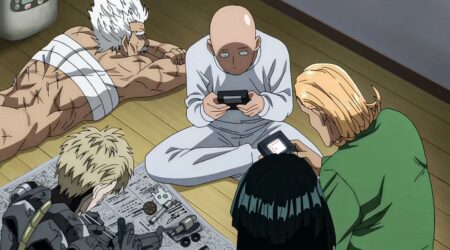There’s no denying the sheer undertaking that is Metallic Rouge Season 1. Directed by Motonobu Hori and written by Yutaka Izubuchi and Toshizo Nemoto, the series strikes an immediate tone as it seeks greater thematic ambitions and dense science-fiction. There’s no waiting for the audience to catch. Instead, it drags any stragglers along with them as new questions and mysteries pile on each episode. From Studio Bones, Metallic Rouge is a blistering, charming, beautifully animated series that barely manages to stay afloat amidst its lofty aspirations.
Metallic Rouge Season 1 occurs in a world where humans coexist with androids called Neans. Due to a violent history and a war between humans and Neans, the latter have a program forcing them to be subservient to humans, unable to raise their hands against them without risking death. Amidst this turmoil rises a group known as the Immortal Nine. They seek to bring free will back to Nean society and eradicate humans. Our protagonist, Rouge Redstar (Yume Miyamoto) — known as Metal Rouge — must seek out members of the Immortal Nine and dispatch them. She and her ally Naomi Orthmann (Tomoyo Kurosawa) travel to Mars to track them down.
This, however, is just the surface level of the layers of the plot the series delves into. The series is packed to the brim. We see this from a mid-season betrayal to the many different variants of Neans to other intergalactic beings and major reveals from characters such as Naomi and Eden (Kazuyuki Okitsu). There’s no room for narrative excess. The series keeps its story tight. Though it becomes dizzying to focus on with the abundance of reveals, names, and lore. The density of the story and the writer’s confidence in the viewers’ ability to keep up are the only significant drawbacks. There’s no need to simplify certain elements. Instead, they just needed room to breathe.
The crux of the story is Rouge’s journey to discovering what free will is to her. It’s about how her free will relates to the world she knows and the lives she takes or spares, which is immensely intriguing. Throughout the series, people challenge her views as she faces seemingly immeasurable threats. She questions her place in the universe as a Nean who hunts her kind. What does it mean to be free and make our own choices?
This all comes to a head in the bombastic finale, “Code Eve.” Viewers realize that the madness woven into these characters’ lives stems from one man. A man who made it his mission to puppeteer Nean’s to see if they’re worthy of humans. Or, rather, capable of surpassing them. It’s a major upset to revolutionary characters who realize that their fight for other Neans wasn’t their own. There’s palpable devastation from their learning that even those threads of defiance were settings built into them.

But even when the emotional journey lands the significant moments, it’s never the narrative that genuinely displays what makes Metallic Rouge Season 1 such an engaging watch. Instead, the greatest element is the dynamic between Rouge and Naomi. It’s why the mid-season betrayal with Naomi reporting Rouge leaves such a sour note. Yes, this is remedied. Their relationship is further developed by the end of the series, though ending on a bittersweet note. But the decision still slams the breaks on the narrative. The two of them together are where the series shines.
It’s part of what makes the last two episodes so special. Their development is crucial to the thematic message of what it means to have a soul. This means friendship, relationships, and the willingness to sacrifice ourselves for those we love. It means mourning and going against logic, even if it’s senseless. It means indulgence and recognizing acts of care. Naomi hands her heart to Rouge as an act of defiant love, and it ends up being the defining aspect of the series.
The series also gains momentum in the artistry. Aside from the central theme that’s a little too broad, the music is spectacular. Composers Taisei Iwasaki, Yuma Yamaguchi, and Towa Tei create a score that moves with the necessary tonality, from eerie to playful to whimsical. It helps add greater depth and a sense of urgency. This is especially true as these characters face increasingly bizarre scenarios. The character design is superb and distinctive, elevated further by how the direction captures movement. Despite her grace in battle, Rouge is youthfully clumsy, especially in the beginning episodes. In comparison, Naomi’s confidence comes through in her movement, which is overtly animated.
The supporting characters become increasingly interesting further in the series we go. However, as much as Eden, Ace (Minami Tsuda), Ash (Atsushi Miyauchi), and Jean (Shunsuke Takeuchi) become integral characters who help shade in the world, it’s Rouge and Naomi’s show. While 13-episode series seem to be the norm these days, especially for original works, with such a rich pool of characters and expansive world-building, Metallic Rouge Season 1 would have triumphed even more with a full 24-episode season count.
Despite its messiness in plotting, Metallic Rouge Season 1 is a success. It swings big and doesn’t always connect, but the foundation is strong, and the detailed character work, animation, score, and action all amount to something beautifully bold. It needed more time to breathe. That said, the inherent charisma of Rouge and Naomi and the acceleration of action makes it a worthwhile, if dizzying, experience.
Metallic Rouge Season 1 is out now on Crunchyroll.
Metallic Rouge Season 1
-
Rating - 8/108/10
TL;DR
Despite its messiness in plotting, Metallic Rouge Season 1 is a success. It swings big and doesn’t always connect, but the foundation is strong, and the detailed character work, animation, score, and action all amount to something beautifully bold.








